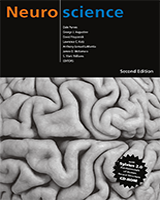By agreement with the publisher, this book is accessible by the search feature, but cannot be browsed.
NCBI Bookshelf. A service of the National Library of Medicine, National Institutes of Health.
Purves D, Augustine GJ, Fitzpatrick D, et al., editors. Neuroscience. 2nd edition. Sunderland (MA): Sinauer Associates; 2001.

Neuroscience. 2nd edition.
Show detailsThe cellular and molecular machinery for olfactory transduction is located in the olfactory cilia (Figure 15.5B). Odorant transduction begins with odorant binding to specific receptors on the external surface of cilia. Binding may occur directly, or by way of proteins in the mucus (called odorant binding proteins) that sequester the odorant and shuttle it to the receptor. Several additional steps then generate a receptor potential by opening ion channels. In mammals, the principal pathway involves cyclic nucleotide-gated ion channels, similar to those found in rod photoreceptors (see Chapter 11). The olfactory receptor neurons contain an olfactory-specific G-protein (Golf), which activates an olfactory-specific adenylate cyclase (Figure 15.6A). The resulting increase in cyclic AMP (cAMP) opens channels that permit Na+ and Ca2+ entry (mostly Ca2+), thus depolarizing the neuron. This depolarization, amplified by a Ca2+-activated Cl- current, is conducted passively from the cilia to the axon hillock region of the olfactory receptor neuron, where action potentials are generated and transmitted to the olfactory bulb.

Figure 15.6
Olfactory transduction and olfactory receptor molecules. (A) Odorants in the mucus bind directly (or are shuttled via odorant binding proteins) to one of many receptor molecules located in the membranes of the cilia. This association activates an odorant-specific (more...)
Olfactory receptor neurons are especially efficient at extracting a signal from chemosensory noise. Fluctuations in the cAMP concentration in an olfactory receptor neuron could, in theory, cause the receptor cell to be activated in the absence of odorants. Such nonspecific responses do not occur, however, because the cAMP-gated channels are blocked at the resting potential by the high Ca2+ and Mg2+ concentrations in mucus. To overcome this voltage-dependent block, several channels must be opened at once. This requirement ensures that olfactory receptor neurons fire only in response to stimulation by odorants. Moreover, changes in the odorant concentration change the latency of response, the duration of the response, and/or the firing frequency of individual neurons, each of which provides additional information about the environmental circumstances to the central stations in the system.
Finally, like other sensory receptors, olfactory neurons adapt in the continued presence of a stimulus. Adaptation is apparent subjectively as a decreased ability to identify or discriminate odors during prolonged exposure (e.g., decreased awareness of being in a “smoking” room at a hotel as the minutes pass). Physiologically, olfactory receptor neurons indicate adaptation by a reduced rate of action potentials in response to the continued presence of an odorant. Adaptation occurs because of: (1) increased Ca2+ binding by calmodulin, which decreases the sensitivity of the channel to cAMP; and (2) the extrusion of Ca2+ through the activation of Na+/Ca2+ exchange proteins, which reduces the amplitude of the receptor potential.
- The Transduction of Olfactory Signals - NeuroscienceThe Transduction of Olfactory Signals - Neuroscience
Your browsing activity is empty.
Activity recording is turned off.
See more...